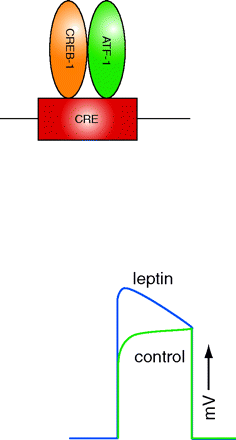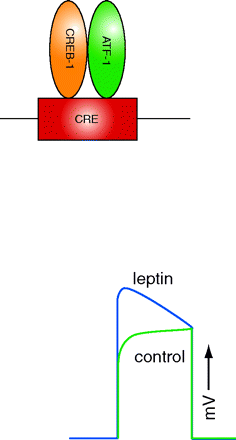Emerging concepts from the recent literature
Leptin Resistance: It’s All in Your Head

Strategies that successfully circumvent leptin resistance could have major therapeutic potential in obesity. In the July 16 issue of Nature Medicine, Bence and colleagues address the role of PTP1B, a nonreceptor protein tyrosine phosphatase encoded by Ptpn1, that negatively regulates downstream leptin and insulin signaling. Mice lacking PTP1B in all tissues are hypersensitive to insulin but also have lower body weight and are resistant to high-fat diet–induced obesity; however, the tissues in which PTP1B functions to negatively regulate insulin and/or leptin signaling are controversial. The authors have therefore created tissue-specific knockout mice, lacking PTP1B expression in either muscle, liver, fat, or brain, and examined adiposity, weight gain, and leptin and insulin sensitivity. Of the tissues examined, the authors report that mice lacking Ptpn1 in neurons manifest parameters most similar to those of whole-body Ptpn1−/− mice, suggesting that effects on leptin and insulin signaling result from PTP1B actions in the central nervous system. These results indicate that anti-obesity therapeutic strategies involving PTP1B will require neuronal targeting. [
] —D Houston, UNC Chapel Hill
Functional Selectivity of the Serotonin Receptor
In a recent posting from JPET, Berg and colleagues report that a selective, high-affinity ligand for the 5-HT2C serotonin receptor has markedly different functional properties, depending on which 5-HT2C-mediated endpoint is assessed. In CHO cells SB 243213 has inverse intrinsic activity for three functions (i.e., PLA2 activation, GTPγS binding, and reduction of constitutive PLC signaling desensitization). Conversely, SB 243213 is a pure neutral antagonist of 5-HT2C-mediated activation of PLC in the same cells. The authors conclude that although a ligand can be pharmacologically described as agonist, partial agonist, antagonist, or inverse agonist, any such descriptor may be valid only for a single functional endpoint in a single cellular context. By coincidence, a posted Perspective in Pharmacology by Urbana et al. reviews the concept of functional selectivity. The authors note that classical terms like “agonist” to describe “intrinsic activity” are both valid and useful, but they highlight the need for refined nomenclature to encompass functional selectivity. [
]—RB Mailman, UNC Chapel Hill
High-Throughput Analysis of Biological Activities
Ever since the days of A.V. Hill, pharmacologists have been exploiting the power of dose-response curves, and teachers have drilled into the minds of graduate students the importance of the shape and nature of such curves for making sound conclusions about the biological actions of small molecules. In a technically fascinating article from a recent issue of PNAS, Inglese and coworkers have married the discriminatory power of classic pharmacology to the speed of high-throughput screening, with pyruvate kinase as their molecular target. This well-characterized enzyme, involved in energy metabolism, is deficient in a form of anemia and implicated in cancer. The authors are able to screen >60,000 compounds in a single experiment, successfully identifying inhibitors and activators that would have been missed by more traditional screening methods based on single-point determinations. The paradigm elaborates profiles rich in information about structure-activity relationships, which can be mined for additional biological activities. [
] —JS Lazo, U Pittsburgh
Alternative Regulatory Mechanism for Transporter Activity

Organic anion transporters are integral to the distribution, excretion, and detoxification of substances such as antibiotics, antivirals, sulfated steroids, and neurotransmitter metabolites. Now online in JPET, Ogasawara et al. examine the mechanisms regulating the expression of human organic anion transporter 3 (hOAT3), the product of the SLC22A8 gene. Deletion analysis of the SLC22A8 promoter indicates elements responsible for basal level activity between −214 and −77 bp, and in fact a CCAAT box and cAMP responsive element (CRE) are indicated; supershift analysis identifies ATF-1 and CREB-1 as transcription factors that bind to the regulatory region. Treatment with the protein kinase A (PKA) activator 8-Br-cAMP increases luciferase activity of reporter constructs that retain a functional CRE. These results indicate that CREB-1 and ATF-1 are responsible for both basal and PKA-induced activity of hOAT3, thus providing an alternative explanation for the upregulation of hOAT3 activity by PKA observed in vivo. [
] —DH Sweet, Medical University of South Carolina
- © American Society for Pharmacology and Experimental Theraputics 2006



